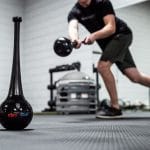In this article, we look at the best exercises for arthritis – whether you have issues with your shoulders, neck, hip, knees, or hands.
Exercise is a vital aspect of maintaining good health. Not only does physical activity promote general wellness, but it can also help reduce pain from your arthritis and increase strength. Let’s look at a few of the best exercises for arthritis. If you’d like to find out more, check out our accredited Arthritis Fitness Specialist course. There are several different types of Arthritis and depending on what type of Arthritis you have will depend on the type of exercise you can do. The most important thing to note here is that movement and exercise should be the first line of defence and must be increased. Otherwise the joints will remain swollen and this can cause further pain. Like all exercise you should apply the principles of progressive overload as well as the ‘Use it or Lose it’ factor.
Perform Better Pro-Ed (previously QPEC) has a combined 70+ years experience in the Health and Fitness Industry. Our dedicated team of Fitness Professionals thrive on training, coaching and imparting our knowledge with the latest research, education, training tools and methods. Browse our fitness courses and sporting equipment today.
Exercise Tips for Those with Arthritis
While low-impact exercise is among the best treatments for arthritis, it is important to take things slow. Pushing yourself too much could cause an increase in pain or discomfort.
The best course of action is to talk to your healthcare provider. They can help you identify which types of exercise might be best suited to you. They will also tell you if they have any concerns about your exercise regime or how often you are exercising. In some cases, they may be able to show you proper exercise techniques or introduce you to additional pain relief exercises. Here are a few tips to bear in mind when exercising with arthritis.
Find Low-Impact Exercise Classes or Online Videos
The benefit of working with a class is that you will have an opportunity to ask questions and address any concerns you may have about working out. If classes are not available or you have a busy schedule, try looking for online exercise videos. This will help you see how some exercises are performed and may help you develop a routine that works well for you.
Don’t Forget to Warm Up
Before you start exercising, you will want to do a few gentle warm-up exercises. Warm-ups prime the connections between your brain and your muscles and nerves, and they also rev up your cardiovascular system, increasing your heart rate.
Don’t Push Yourself
Whether you are planning on taking an hour-long class or you are watching a short video on some basic arthritis exercises, it is important to know your limits. Don’t try several new exercises for a lengthy period of time or try to “work through the pain.” Most people need to slowly build themselves up in order to exercise comfortably and safely.
What Exercises Are Good for Arthritis?
There are several different exercises that are safe for people with arthritis. The ones you choose will depend on your overall physical condition and the areas you are trying to strengthen.
Walking
Walking is among the best exercises you can do for arthritis. It can be easy to judge how much you can walk before feeling pain or fatigue. Walking outside can also promote muscle endurance, increase energy levels, and reduce stress. If you can’t or don’t want to walk outside, invest in a reliable treadmill or elliptical.
Aerobics
Light aerobics classes are a great type of exercise for people with arthritis.
Low Impact Aerobics classes are great to give people a good gentle range of motion through most full body movements which in turn will improve circulation, aerobic capacity and balance.
While some aerobics classes may encourage you to use a machine, there are several that encourage you to bend, stretch, and move in a variety of ways. One of the benefits of aerobics is that you can usually work your way up to more intense or lengthier exercises. Try some resistance band exercises as a way to start!
Aqua Aerobics
Aqua Aerobics is one of the best types of exercise to do as the water creates little impact to any of the muscles or bones and it allows you to do ranges of motion that are generally more restrictive to do on land. The water also acts as a cooling and buoyant support to the body to enable you to exercise more freely.
Stretching
You don’t need an intense workout to get the benefits of exercise. Stretching can be done a few times per day and is a great choice for people with arthritis. The goal is to slowly improve the strength, mobility and flexibility of your joints. For example, some popular hand exercises for arthritis only require you to stretch your fingers out ten times by touching your fingertips to your palm. Sometimes, the simplest movements can have the biggest impacts!
Swimming
Swimming is a fantastic low-impact way to help you gently work out your entire body while putting less stress on your joints. Find a local pool that you can go to on a regular basis to really reap the benefits of swimming for arthritis.
Tai Chi
Tai Chi has proven to be an exercise with significant benefits in the areas of balance, upper- and lower-body muscular strength and endurance, and upper- and lower-body flexibility, particularly in older adults. After just six weeks, statistically significant improvements were observed in balance, muscular strength, endurance, and flexibility measures. Improvements in each of these areas increased further after 12 weeks.
There are several different styles of Tai Chi that involve slow, controlled movements. Because most poses are low impact, tai chi can be incorporated into a variety of routines. This Chinese martial art form can also help improve balance and posture. Because Tai Chi classes can vary in difficulty, it is best to work with an instructor who has experience working with arthritis patients. If you or a loved one has arthritis and would like to learn how to harness the power of Tai Chi, why not take our Tai Chi Instructor Course for Beginners?
Yoga
A good yoga class will include a wide range of balance, muscle-building, and flexibility exercises. Much like tai chi, yoga focuses on gentle movements, making it a good choice for people with joint pain. While some people use the hip, knee, neck, or shoulder arthritis exercises that yoga includes, many people find it is a total body workout. Don’t make the mistake of underestimating the intensity of yoga! Before you begin, talk to an experienced instructor about your condition to choose the intensity level that is right for you – and make sure you have the best yoga equipment to make the most of your sessions.
How Often Should You Exercise?
When using exercise to improve your arthritis, it can be tempting to try and work out as much as possible. While incorporating more activity into your routine can be a good thing, you need to make sure to give your body a rest. At first, you may only want to work out a few times per week. To maximise your results, be sure to perform a variety of exercises for arthritis each week.
Remember, if certain movements are causing you pain or you aren’t sure how to perform a specific exercise, contact your healthcare provider or an experienced instructor. Seeking professional assistance can help you avoid further injuries or aggravating your symptoms.
Perform Better Pro-Ed (previously QPEC) has a combined 70+ years experience in the Health and Fitness industry.
Perform Better Pro-Ed (previously QPEC) has a combined 70+ years experience in the Health and Fitness industry.







